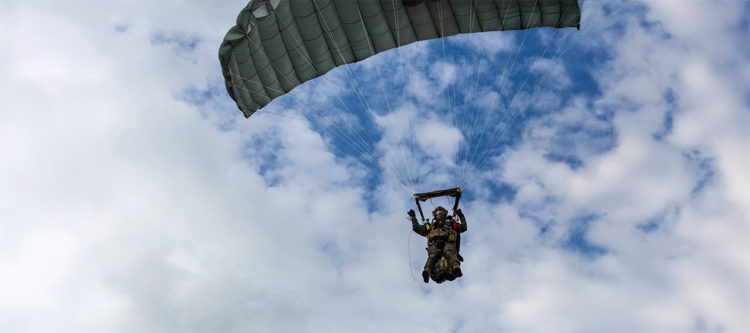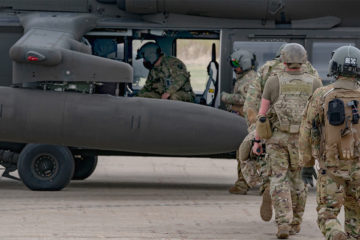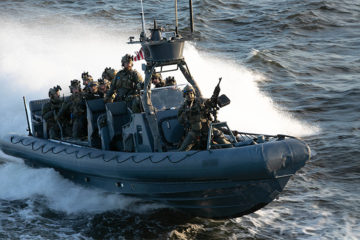Mobile mesh networking – a vital tool for airborne operations

Few military exercises and operations are as harrowing and complex as military airborne and freefall operations. Despite the extensive jump training and pre-deployment experience that is required for all airborne operators to complete, there are inherent challenges and unknown factors that could cause problems for even the most experienced airborne operator.
As former Special Forces Operations Sergeant for the U.S. Army, George Servino Jr., previously explained to The Last Mile:
“With hundreds of pounds of tactical gear strapped to their bodies, jumping from the aircraft can be challenging. With the added weight, these operators exit the aircraft at high speeds, which can cause them to tumble and quickly lose control. For a successful freefall jump, the operator must conduct a perfect exit [and] safely deploy their parachute…all while avoiding a mid-air collision or any other potential parachute malfunctions due to operator error.”
The unpredictable, dangerous, and complicated nature of military airborne and freefall operations makes it essential to track the physical location of units from the time they leave the plane until the time they land. Secure, fail-safe communications capabilities ensure that airborne units can maintain their safety, share their status and location, and request help when needed.
A natural technology fit for airborne operations
goTenna mesh networking technology is a natural addition to the Primary, Alternate, Contingency, and Emergency (PACE) plan for airborne units and military freefall operations. Because of the small size, light weight, and low power requirements of goTenna devices, they can easily be carried by airborne operators without adding significant weight to their kit, and can stay powered on and active for long periods of time both during and after jumps.
With electronic warfare capabilities becoming incredibly effective at locating signals to identify troop locations and movements, deploying a low signature communications solution that is difficult to detect and intercept is incredibly important – especially for airborne operators.
Also, thanks to the low cost and ease of use, mesh networking devices – such as the goTenna Pro X2 – are easy to deploy to every airborne operator in the unit. Instead of deploying a single, heavy radio to just one member of the unit, each operator can be issued a device prior to the mission, which can be quickly and easily used to establish an ad hoc, interoperable network across the entire unit.
In addition, the low signal footprint makes mesh networking an excellent alternative for airborne operators facing today’s more sophisticated adversaries. With electronic warfare capabilities becoming incredibly effective at locating signals to identify troop locations and movements, deploying a low signature communications solution that is difficult to detect and intercept is incredibly important – especially for airborne operators.
All of these mobile mesh networking benefits were on full display as the goTenna team demonstrated its solutions for the Spanish Air Force during a recent field exercise to simulate a search and rescue effort for finding and recovering a lost and injured airborne operator. The demonstration was designed to explore how goTenna technology can be used in scenarios when airborne operators are lost, can’t ask for help or share their location with their teams.
A critical communications solution for airborne search and rescue
During this exercise, the Spanish Air Force worked with goTenna engineers to establish a field test that would mimic a lost and disabled airborne operator located more than five kilometers away from the rest of the unit.
…this exercise…[mimicked] a lost and disabled airborne operator located more than five kilometers away from the rest of the unit. In this test scenario, the airborne operator was positioned to be lying on the ground on top of a goTenna Pro X2 device.
In this test scenario, the airborne operator was positioned to be lying on the ground on top of a goTenna Pro X2 device. The airman’s position caused a partial obstruction of the device, which resulted in a loss of line-of-sight communication.
To ensure that the airborne operator could be detected and located over a large geographic area, the team mounted another goTenna Pro X2 to a drone, which was elevated to approximately 20 feet above the ground. This expanded the goTenna network coverage and reach, and despite the obstruction of the downed operator’s device and loss of line-of-sight communication, the Spanish Air Force was able to identify the downed operator’s location and reestablish communication for a rapid recovery mission.
Proof of concept for airborne operator safety and survivability
During this recent field exercise, the deployment of the goTenna mesh networking technology with Pro X2 devices enabled search and rescue success for the Spanish Air Force in rapidly identifying the location of and re-establishing communication with a lost and injured airborne operator for an expedited recovery effort.
The results of the goTenna demonstration with the Spanish Airforce provide a strong proof of concept and justification for including mesh networking technology in military airborne PACE plans to significantly boost airborne operator safety and survivability, especially in search and rescue scenarios.









No Comment